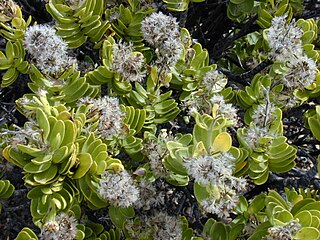Located about 2300 miles (3680 km) from the nearest continental shore, the Hawaiian Islands are the most isolated group of islands on the planet. The plant and animal life of the Hawaiian archipelago is the result of early, very infrequent colonizations of arriving species and the slow evolution of those species—in isolation from the rest of the world's flora and fauna—over a period of at least 5 million years. As a consequence, Hawai'i is home to a large number of endemic species. The radiation of species described by Charles Darwin in the Galapagos Islands which was critical to the formulation of his theory of evolution is far exceeded in the more isolated Hawaiian Islands.

Argyroxiphium is a small genus of plants in the family Asteraceae. Its members are known by the common names silversword or greensword due to their long, narrow leaves and the silvery hairs on some species. The silverswords belong to a larger radiation of over 50 species, including the physically different genera Dubautia and Wilkesia. This grouping is often referred to as the silversword alliance. Botanist P. H. Raven referred to this radiation as "the best example of adaptive radiation in plants".

Dubautia or na'ena'e is a genus of flowering plant in the family Asteraceae. The genus was named after Joseph Eugène DuBaut (1796–1832), an officer in the French Navy who participated in Freycinet's expedition.

Udea is a genus of snout moths in the subfamily Spilomelinae of the family Crambidae. The genus was erected by Achille Guenée in 1845. The currently known 216 species are present on all continents except Antarctica. About 41 species are native to Hawaii.
Udea calliastra is a moth of the family Crambidae. It is endemic to the Hawaiian islands of Maui, Kauai, Molokai, Oahu and Hawaii.
Udea liopis is a moth of the family Crambidae. It is endemic to the Hawaiian islands of Maui, Hawaii, Kauai, Oahu, Molokai and Lanai.
Udea constricta is a moth of the family Crambidae. It is endemic to the Hawaiian islands of Kauai, Oahu and Molokai.
Udea despecta, the Hawaiian sweetpotato leafroller, is a moth of the family Crambidae. It is endemic to the Hawaiian islands of Kauai, Oahu, Molokai, Maui, Lanai and Hawaii.
Udea dracontias is a moth of the family Crambidae. It is endemic to the Hawaiian island of Kauai.
Udea dryadopa is a moth of the family Crambidae. It is endemic to the Hawaiian islands of Kauai, Oahu and Maui.
Udea ennychioides is a moth of the family Crambidae. It is endemic to the Hawaiian islands of Kauai, Oahu and Maui.
Udea eucrena is a moth of the family Crambidae. It is endemic to the Hawaiian islands of Kauai, Oahu, Maui and Hawaii.
Udea lampadias is a moth of the family Crambidae. It is endemic to the Hawaiian islands of Maui and Hawaii.
Udea thermantis is a moth of the family Crambidae. It is endemic to the Hawaiian islands of Kauai, Oahu, Molokai, Maui and Hawaii.
Udea thermantoidis is a moth of the family Crambidae. It is endemic to the island of Hawaii.
Udea monticolens is a moth of the family Crambidae described by Arthur Gardiner Butler in 1882. It is endemic to the Hawaiian islands of Kauai, Oahu and Hawaii.
Udea pyranthes is a moth of the family Crambidae. It is endemic to the Hawaiian islands of Kauai, Oahu, Molokai, Maui and Hawaii.
Udea platyleuca is a moth of the family Crambidae. It is endemic to the Hawaiian islands of Oahu, Molokai, Maui and Hawaii.
Dubautia syndetica, the Wahiawa dubautia, is a plant species endemic to the island of Kauai in the state of Hawaii. It is found only in the upper portions of the Wahiawa drainage basin at elevations of 680–950 m.
This page is based on this
Wikipedia article Text is available under the
CC BY-SA 4.0 license; additional terms may apply.
Images, videos and audio are available under their respective licenses.


